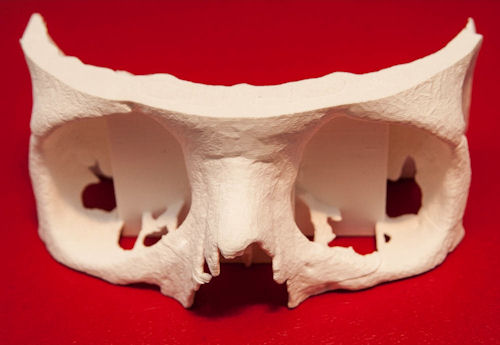Latest News
March 8, 2013
 |
After President Obama said in his recent state of the union address that 3D printing “has the potential to revolutionize the way we make almost everything,” comments—even by engineers—on websites like CNN got hot until displaced by important news about the Kardashians. People were frightened about what the technology holds for manufacturing employment. My complaint about the POTUS’s POV was that he did not go far enough. 3D printing is not just for manufacturers to make parts and prototypes, as terrific as that is. 3D printing is also for the clever in every field to revolutionize the way they conceive of and do things, the effects of which hold vast potential for new fields of endeavor. Consider today’s Check It Out.
“Doctors in Belgium Use Mcor Paper-Based 3D Printing to Dramatically Reduce Surgical Time” is a brief read. It’s all there on a single web page. But it’s long on potential. The gist of the story is this:
A surgical team in Belgium has put a Mcor 3D printer to work in their preparations for maxillofacial repair and reconstruction surgery. What they do is use scans of a patient’s bones to build a 3D replica of the patient’s unique physiology. The model serves as a surgical guide for creating custom-fitted implants. Because most of the fitting is done prior to surgery, actual surgery time is minimized which, in turn, reduces the damage to soft tissue, making recovery speedier. The surgeons also estimate that they shave an hour off a typical surgery, which is a money saver and something their patients surely appreciate.
But there’s more to this story than that.
Mcor’s technology, you might recall from previous DE coverage, uses paper as its additive manufacturing medium. The advantages of that process are many in the health field. For example, eco-friendliness. The Mcor process doesn’t have nasty chemicals or waste products to deal with. You can toss the final model into the paper recycling bin. The paper can be sterilized, so the surgeons even are considering bringing models into the OR. The per model cost is probably half that of a resin-based part, and Mcor 3D print systems are not pricey in the scheme of things either. The surgeons estimate they’re saving more than $26,000 a year on paper-based models alone.
And then there’s the future. As the surgeons become better at leveraging their Mcor system, they see more surgical usages for it in their field as well as other biomedical engineering and medical device engineering applications.
So, in this brief case study, we’re talking about custom medical designs, one-offs, as well as time and money saved and spent well. And we’re also talking about the potential to make real and to conceive of things that once were unimaginable. That seems revolutionary to me. Hit the link over there, give this case study a read, and see what you think.
Thanks, Pal. – Lockwood
Anthony J. Lockwood
Editor at Large, Desktop Engineering
Read: Doctors Use Mcor Paper-Based 3D Printing To Dramatically Reduce Surgical Time
Subscribe to our FREE magazine, FREE email newsletters or both!
Latest News
About the Author
DE’s editors contribute news and new product announcements to Digital Engineering.
Press releases may be sent to them via [email protected].






